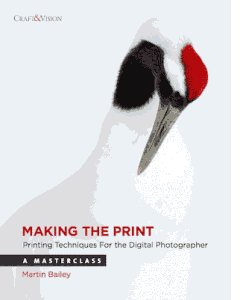Almost every photographer I know at some point wants to make some prints of their work. There are lots of options, you could buy an inexpensive printer and print yourself. You could also buy a more professional wide format printer and get as sophisticated as you would like, or you could use outside printing resources. By outside printing sources, I mean uploading or taking a file and getting it printed. There are many online places and also Costco and other warehouse stores. There is also the local photo printing store, although those are becoming fewer and fewer. A lot of choices, but it really depends on the desired results. Does the final quality of the print matter a great deal or just a little? What sizes and types do you want to make and this is just for starters. So where do you go to learn how to make a print? There are lots of references on the internet, some great, some not so good with outdated information. I know I went through this when I decided I wanted to get a quality printer. I went to a lot of sites and asked a lot of questions, and I finally settled on an Epson 4880 printer. Epson has come out with newer models since then but I love using my printer and the output is really great, much better than I had been getting using an outside printing source. The best prints come from a sound techniques and knowledge of how to control the process. So how do you get this knowledge? I found two sources that really cover the material needed. Both are very new and I wish I had them when I was first going down this path.
For a really good introduction and to cover a lot of useful ground, there is a new ebook from the Craft and Vision people, called Making the Print by Martin Bailey. (If you use the code “PRINT4” before midnight on the 21st of January 2012, you can get it for $4 instead of the normal $5, or save 20% on 5+ pdf using the code “PRINT20”.) This ebook may be low cost but it is packed with lots of useful information. Enough information to make you decide whether or not you want to pursue printing on your own, and it will also give you enough information to use an external printing resource with a color managed output. This little ebook covers all the basics from types of paper, to color management and printing. There is also a chapter on doing gallery wraps on canvas. While the ebook is not intended as an in-depth tutorial it will give you enough information to get started and perhaps enough to do just want you want to do. Like anything in life you can make this as complex or as simple as you like but what matters is the end result.
If you want to get more in depth discussions and you like learning by watching videos than this next item is for you. This is a video tutorial covering everything from capture to printing to displaying on screen. It is about 12.5 hours long and is broken up into chapters. This video tutorial goes into greater depth than the ebook but also costs more. The video features Michael Reichmann and Jeff Schewe, both very accomplished photographers with a tremendous amount of knowledge. It is available for purchase and download from the Luminous Landscape web site and is called Camera to Print and Screen. Production quality and the information is top notch. This was only recently made available and even though I have done a lot of research I still learned a lot from watching these video tutorials.
Both of these are very useful resources and will help to steer anyone interested in printing their own pictures down the correct path to yielding great prints. They are certainly not the only reference but I find both of them to very useful and will really streamline the learning curve.

